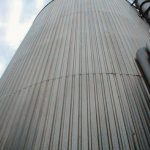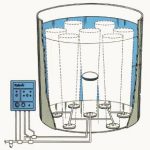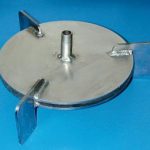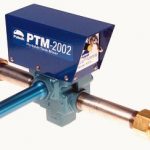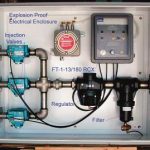The outstanding feature of the Pulsair mixing system is that it utilises no moving parts within the tank. The key to the formation of the bubble masses is Pulsair’s accumulator plate, a disk of metal or other material, which is fastened horizontally just above the bottom of the tank. Customers around the world have adopted this reliable and effective mixing technology to mix various liquids.
Craig Johnston
Twenty years ago a mechanical engineer from Seattle was challenged with coming up with an effective way of mixing brining salmon eggs. He knew mechanical mixer blades would crush the fragile eggs. His solution was to feed pulses of compressed air into the bottom of the brining tank, creating bubble masses. As the bubble masses rose, they gently mixed the brining solution without damaging the salmon eggs. The engineer, Dick Parks, patented the process, and today his company, Pulsair, provides mixing solutions used around the globe to mix fuels, lubricants, food, wine, paints, wastewater and a host of other liquids.
No moving parts in the tank
Many industrial mixing operations are 24-hour-a-day, seven-day-a-week operations. Mixer downtime can be expensive, not only in terms of the cost of parts and repairs, but from process shutdown time due to emptying the tank and loss of prod-uct. Pulsair’s mixing application utilises no moving parts within the tank. No moving parts means nothing to break, no need to empty the tank and no process downtime. In fact, the only parts inside the tank are flat disks, called accumulator plates, which form the bubble masses, and the plumbing to deliver the air pulses to the plates. Outside the tank is a compressor and the Pulsair equipment controlling the air pulses. The Pulsair system is scalable. Small containers, like 150 l drums, as well as some of the largest tanks in the world can be mixed.
For example, Pulsair is used to mix two 11 000 m³, 27 m diameter bunker fuel blending tanks at the Petronas facility in Kuala Lumpur. The company also mixes a 34 m diameter, 300 t red wine-fermenting tank at Lindemans Winery, Karadoc, Australia. For winemaking and other oxygen-sensitive mixing applications, Pulsair can pulse nitrogen or other gases instead of ambient air.
Simple and effective
When the Pulsair system was developed, streams of bubbles had long been used in mixing liquids. But this continuous mass-of-bubbles process, known as sparging, uses a lot of energy and has a tendency to entrain oxygen in the liquid. Parks found that if a bubble mass is sent up through the liquid, it pushes the liquid above it upwards and drags the liquid below along too. When the bubble mass breaks the surface, the liquid it has lifted continues in motion across the top of the tank and down the sides. This momentum means that waiting to send the next bubble mass until the liquid in motion slows down may save energy. And although it seems counter-intuitive, the Pulsair mixing system entrains little oxygen in the contents it mixes due to the relatively small surface area of the pulsed bubble mass. As mentioned earlier, Pulsair can use nitrogen or other gases to mix materials that are oxygen-sensitive.
Sophisticated controllers meter the amount of air delivered in each pulse. By controlling the air pressure, the duration of the pulse and its frequency, technicians at a plant can vary the mixing properties to meet process requirements while minimising energy costs. The key to the formation of the bubble masses is Pulsair’s accumulator plate, a disk of metal or other material ranging from 15 to 55 cm in diameter, which is fastened horizontally just above the bottom of the tank. When air is pulsed beneath the centre of the accumulator plate, it wraps around the plate’s edges and forms into a bubble mass over the top.
An additional benefit of the air pulse coming out of the accumulator plate is that it sends a shock wave across the floor of the tank, loosening solids that have settled on the bottom. With this mixing system, the mixing process commences at the very bottom of the tank, which allows it to start mixing as the tank begins to be filled and conversely, can keep the product mixed as the tank is emptied. The accumulator plate and in-the-tank plumbing can be constructed of steel, stainless steel, aluminium, fibreglass, PVC plastic or other materials, depending on the contents to be mixed in the tank. Some Pulsair applications can forgo the accumulator plate and inject the pulse directly into the bottom of the tank.
Mixing larger tanks
Pulsair’s mixing properties vary with the tank shape and depth, but a general rule of thumb is that the Pulsair system mixes most effectively within a 15 cm radius of the location of the accumulator plate. For large tanks, Pulsair employs arrays of accumulator plates. For instance, in Lindemans‘ 34 m diameter wine-fermenting tanks, Pulsair employed 29 of its 55 cm diameter accumulator plates, using one plate in the centre with three concentric circles of plates around it. Rather than pulsing all the plates at the same time, groups of plates are pulsed sequentially for maximum mixing effectiveness and energy savings.
The pulsing of the mixing system can be controlled with either a controller or software incorporated into a facility’s plant automation system. Pulsair’s touchscreen controllers are designed to control a single tank or a whole tank farm. Tanks can be individually controlled to start and stop mixing cycles and to vary them according to the mixing process needs. The touchscreen controllers also allow a mixing facility to start small, controlling a single tank or several tanks, then scale up to a larger number of tanks by reprogramming the touchscreen and adding modules. In explosive environments, Pulsair can control its pulsing by pneumatic means, eliminating the possibility of an electric spark.
Portable mixing solutions
The Pulsair mixing process is also ideal for mobile mixing needs, and the company has developed a range of portable mixers for various applications. The 5–55 Drum Stick can be used for mixing 150 l drums and other small containers. The Drum Stick has a small accumulator plate to allow it to be inserted through the bung fitting at the top of the drum. For industry standard tote containers, the company developed the 10–55 Tote Stick, with an optional folding array of accumulator plates to mix along the edges of a tote container. Both the Drum Stick and Tote Stick can be used to mix other small containers.
For larger containers, such as tank cars and rail tank cars, Pulsair developed a range of portable hand-held mixers – the PTM-2000 series. This series ranges from 19 to 110 m³ portable mixers. For tank contents that need to be heated in order to be mixed, heated air or steam can be pulsed into the contents to speed the warming process.
Applications worldwide
Since its introduction over 20 years ago, Pulsair has become a preferred mixing process throughout the world. In addition to the bunker fuel and wine mixing applications, Pulsair has been called upon to mix a wide variety of products. Plant managers aren’t the only ones who like Pulsair mixing systems, as a case study from a Texas, USA, lubricant mixing facility shows. The customer has a 315 m³ tank in which he blends bright stocks and neutral oils to be used as a base stock for other lubricants. He needs to have the mixed base stock ready for shipment at 9 a.m. each day. Prior to the installation of Pulsair, the customer used a 22 kW side entry mixer to mix the tank and a 73 kW pump to recirculate the contents during mixing. In addition, a boiler was employed to heat the oil to assist with the blending. Pulsair replaced the mixer and pump with a 11 kW compressor and turned the boiler down to half its original setting. Energy savings alone came to over 80 %. Using the mechanical mixer required a crew of two men starting work at midnight in order to blend the tank. With Pulsair the plant starts the crew at five in the morning and still meets the schedule, cutting manpower costs by more than half. This resulted in a real saving for the plant of over $300 per daily batch.
cpp 424
More about the products
Virtual exhibition for mixers, agitators and kneaders
Share:



